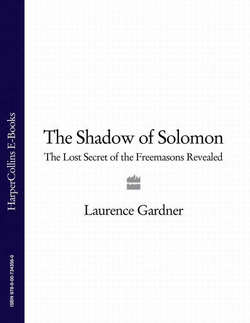Читать книгу The Shadow of Solomon: The Lost Secret of the Freemasons Revealed - Laurence Gardner - Страница 17
3 Royal Society The Transition
ОглавлениеIt is on record that the first mason to be installed south of the Scottish Border was the statesman Sir Robert Moray. Knighted by King Charles I, this eventual close friend of Charles II was made a Freemason at Newcastle in 1641.1 Freemasonry was very much a part of the Stuart tradition and, in 1601, King James VI of Scots had been initiated at the Lodge of Scone two years before his arrival in London as James I of England. His son and grandson, Charles I and Charles II, were also both patrons of Freemasonry.
Moray’s initiation does not strictly qualify as an English installation because the lodge concerned was a travelling branch of the Lodge of Edinburgh, and Moray was himself a Scot. But Elias Ashmole, the antiquarian and founder of Oxford’s Ashmolean Museum, was subsequently initiated into Freemasonry at Warrington, Lancashire, in October 1646. Hence, he is officially regarded as being England’s first home-grown Freemason. His diary, however, gives the names of those present at his induction and, as pointed out by the Curator of the United Grand Lodge of England some years ago, the seven men who formed this lodge must have been Freemasons before Ashmole.2 It is, therefore, clearly incorrect to claim that Freemasonry in England began when four gentlemen’s tavern clubs amalgamated to form a Grand Lodge in 1717.
Ashmole’s keen interest and involvement in hermetic magic is not generally mentioned in masonic works concerning him, since a practising alchemist is not the desired image of England’s first Freemason. In contrast, however, the Ashmolean Museum has no problem with the subject, and makes the point that Ashmole used the pseudonym James Hasolle for his first book on alchemy, Fasciculus chemicus.3 The fact that Ashmole was also Windsor Herald and Treasurer of the College of Arms holds a far greater appeal for idealized masonic society, but in Restoration times these two seemingly diverse facets would have been unremarkable. His Theatrum chemichum Britannicum, published in 1652, was of primary importance to the Rosicrucian movement (see page 49) in that it was a collated synthesis of English alchemical texts, and became a valuable reference source for manuscripts otherwise hard to access.
It is beyond dispute that Freemasonry of a ‘speculative’ style came into England from Scotland when the two Crowns were united in 1603. But it is also apparent that in ‘operative’ terms the London Company of Freemasons was granted a coat of arms as far back as 1472. Equally interesting is the fact that in 1655 the name was changed to the London Company of Masons. This appears to indicate that the word Freemason had taken on a new connotation—relating now more to a speculative craft, rather than to a particular form of operative stonemasonry. This still does not explain why the word Freemason is not found in etymological dictionaries of the early 1700s, but it does suggest that a key operative guild wished to draw a distinction between its own membership and that of the speculative lodges.
It appears that Freemasonry has been portrayed very strangely since 1723—a hotchpotch of disconnected legends and a general lack of cohesion, with the reason given that the truly enigmatic secrets had been lost. The actual reason for the vagueness of otherwise intellectual men was not so much that everything had gone missing after the 1688 Revolution. It was more a question of their obstinacy in not acknowledging the facts of the matter. Information was there to find if Anderson and his allies had cared to look, but the political situation was such that they preferred not to do so.
This attitude arose after 1715, when James Francis Edward Stuart, the son of the exiled King James II (VII) made a bid to regain the crowns of his ancestral heritage. Soon after the coronation of George I, James Francis was proclaimed as the rightful King James VIII of Scots by Stuart adherents in Aberdeen, Brechin, Dundee, Montrose, Perth, St Andrews and Edinburgh. He then sailed to Scotland from Dunkirk, and in September that year his standard was raised at Braemar. His supporters seized Inverness and Perth from the Hanoverian guard, but they failed to take Edinburgh and Stirling castles, and their advance was halted at Sherriffmuir. South of the Border their penetration was feeble, and within a few weeks the 1715 Rising was terminated by a surrender at Preston, Lancashire, on 14 November. Soon afterwards, the deflated James Francis returned to France.
Despite its initial enthusiasm, the 1715 rebellion was one of the worst campaigns ever organized. But it was not destined to be the last Stuart attempt at restoration, and the people of Britain began to question their personal loyalties and sympathies: Were they Stuart or Hanover supporters?
In Latin, the name James is rendered as Jacobus—and from the time of the Stuart exile, their supporters had become known as Jacobites. Pre-1688 Freemasonry in Scotland and England had ostensibly been a Jacobite institution. But the post-1717 English variety of Anderson and his friends was essentially Hanoverian—a newly devised pseudo-masonry with no real provenance of its own. Whatever information might have been available from previous sources, it would have been unacceptable to the hard-line Hanoverians because it was of Scottish origin. Consequently, much of the new-style English Freemasonry has since bewildered masons and non-masons alike because its weak, often incomprehensible, tradition leaves so much to be desired. Only the introduction of charitable objectives and precepts of moral idealism appear to give it any meaningful substance, but we should not judge too hastily in this regard since there is a good deal more to uncover. Meanwhile, back in 1738, since Christopher Wren was a deceased mason of the old school it was convenient to blame him for spoiling everything!
